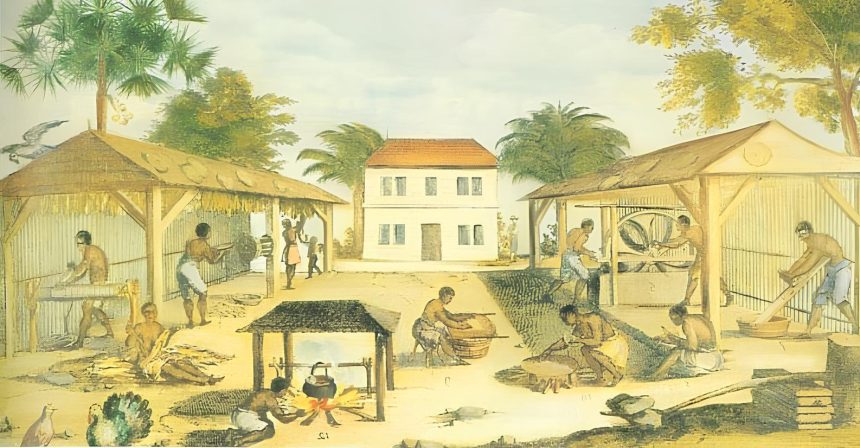To understand the history of tobacco, we need to go back several years. “Tabaco” in Spanish in the 16th century refers to both the plant, the cigar made from its leaves, and the pipe used by the Arawak Indians to smoke a mixture of several herbs including tobacco. Its cultivation originated in America about 600 years ago: the Indians considered tobacco a precious plant, used for medicinal purposes and in purification rituals.
In October 1492, dried tobacco leaves were offered to the crews of the caravels landing on the island of San Salvador; this was the first documented contact between Europeans and tobacco. Christopher Columbus mentions that the Indians burned tobacco (called “petun”) with pieces of charcoal and inhaled the fragrant smoke. Others smoked peace pipes, chewed, or inhaled a kind of powder made from dried leaves.
History of Tobacco: its arrival in Europe
Initially a simple ornamental plant in Spain, tobacco was cultivated and used as a medicinal plant in the 1520s in Portugal. It was introduced to France in 1556 by the explorer-geographer André Thevet, who, (returning from a stay in Brazil to establish a French colony in the Bay of Rio) developed its cultivation in his native town of Angoulême. It was then called “Angoulême herb” or “petun herb”. In 1560, the French ambassador to Portugal, Jean Nicot, sent tobacco powder to Catherine de’ Medici to treat the terrible migraines of her son Francis II. Tobacco became the “queen’s herb” and its sale in powder form was reserved for apothecaries
By the end of the 16th century, tobacco was known worldwide; in 1572, one of the first treatises on tobacco as a medicinal plant, “L’instruction sur l’herbe petun,” by physician Jacques Gohory, was published. In honor of Jean Nicot, tobacco was named “nicotiana,” a proposal adopted by botanist Jacques Daléchamps in his book “Histoire générale des plantes” in 1586; this terminology would be taken up by botanist Carl Von Linné in the 18th century, in the form “Nicotiana tabacum.”.
The Success of Tobacco
Its cultivation was introduced in 1580 in Turkey and Russia; around 1590, tobacco arrived in India and Japan. From the 1620s, tobacco cultivation took root in the territory of the Kingdom of France. Its rapid success was due to the fact that the plant yielded much more per unit of agricultural land than wheat, flax, or hemp, and that its cultivation was suitable for the workforce of a small family farm. The first trials of introducing the plant took place near Strasbourg, and tobacco cultivation spread to southern Alsace from the end of the Thirty Years’ War (1618-1648).
Tobacco would become the pioneering resource of the new colonies in the West Indies; its cultivation attracted indentured servants to the French islands of Martinique, Guadeloupe, and Saint-Domingue. It was the engine of the West Indies’ settlement by the white population until the last third of the 17th century, when sugar cane cultivation (and its large plantations using slaves from Africa) came to replace tobacco. The state sought to promote tobacco cultivation on the kingdom’s territory and make it a source of tax revenue, first through taxes and then by establishing a monopoly on manufacturing and distribution.
Colbert established a “privilege of manufacture and sale” in 1674; the first “tobacco manufactories” were founded in Morlaix, Dieppe, and Paris. Production became a royal monopoly in 1680: French tobacco cultivation was the most developed in Europe, with plantations in Brittany, Normandy, Aquitaine, Flanders, Franche-Comté, and Alsace. The management of taxes on tobacco consumption was leased to financiers (called farmers) through a lease that guaranteed the state a fixed global sum in advance; this was the Tobacco Farm included in the General Farm in 1726.
Smuggling and Competition
Tobacco smuggling developed on the French Atlantic coasts, particularly on the island of Noirmoutier. The search for quick profits by large-scale trade dictated a low purchase price for West Indian planters, especially when the more profitable sugar cane cultivation tended to replace tobacco from the colonies. It was indeed the strategy of selling and buying prices that profoundly modified global tobacco production at the end of the 17th century. Moreover, the new monopoly imposed by Colbert in 1680 encouraged traders to settle in Amsterdam and Liverpool to buy tobacco from the French West Indies and then blonde tobacco from Virginia, which was cheaper and increasingly popular with consumers.
It should be noted that American planters in Virginia imported African slaves through the Senegal Company (French), created in 1673. It replaced the West India Company founded in 1664 by Colbert (and suppressed in 1674); this was focused on tobacco development and perceived by planters as a hindrance to the growth of sugar cane in the West Indies. In thirty years, French imports went from 20% to 70% of domestic tobacco consumption. Virginia alone accounted for 60% of French imports, and by the mid-18th century, the American colony became the world’s leading tobacco producer.
Cultivation was prohibited from 1719 in the Kingdom of France (during the Regency and the implementation of Law’s System), except in Flanders, Artois, Hainaut, Franche-Comté, and Alsace, and imports were reserved exclusively for the East India Company. By the end of the 18th century, the production of manufactories supplied by colonial tobacco reached 7,000 tons per year. The lifting of the prohibition was effective by the decree of March 20, 1791, which established the freedom to cultivate, manufacture, and sell tobacco in France.
In 1805, sixteen departments cultivated 8,000 hectares with a production of 9,000 tons; in 1808, forty-six departments produced 22,000 tons of tobacco. The decree of December 29, 1810, re-established a state monopoly for the purchase, manufacture, and sale of tobacco. In 1821, the Dictionary of Medical Sciences cited tobacco among the plants “whose qualities, dangerous because of their too great activity and their action in some way corrosive on tissues, should make its use very rare.”


